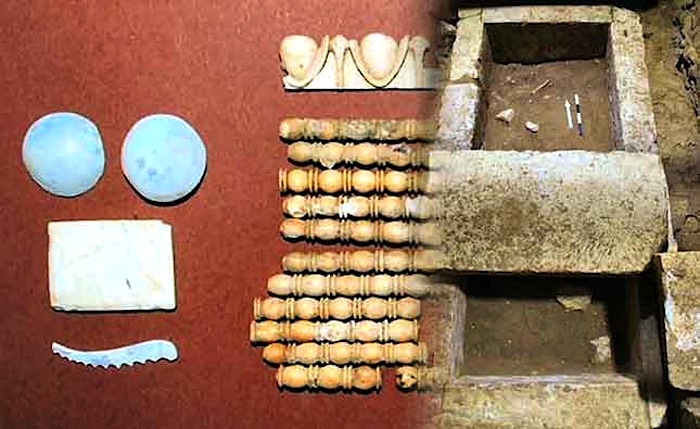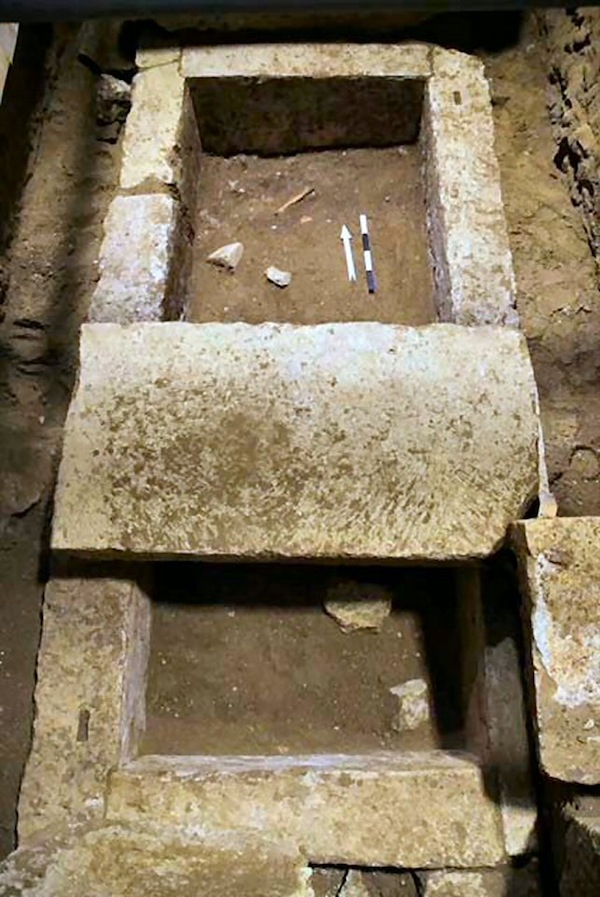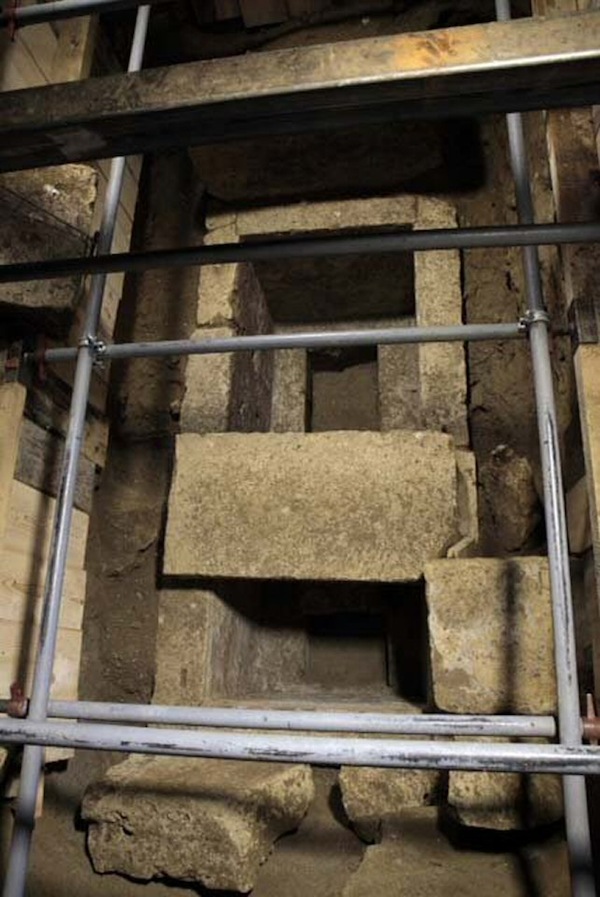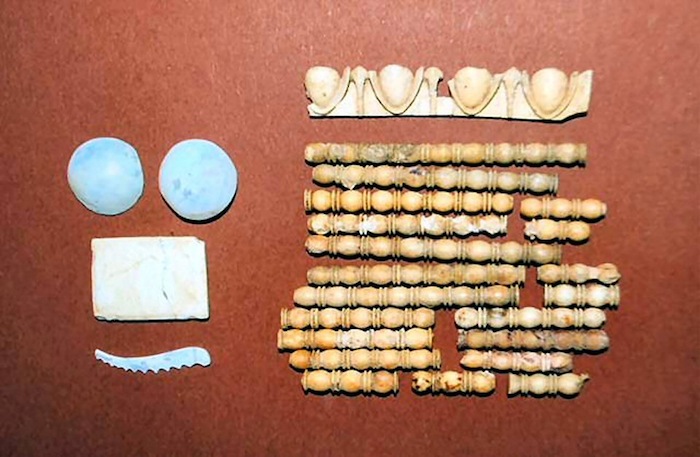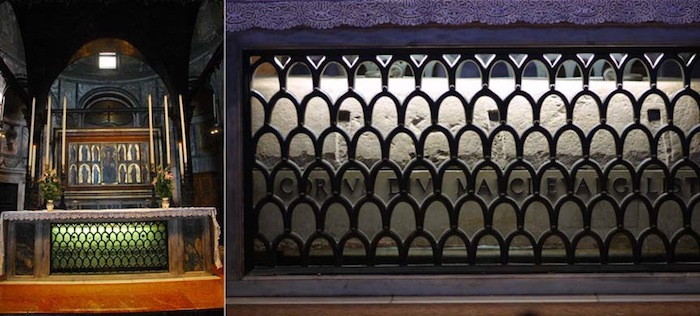By Andrew Chugg*
I wrote my initial article on this question on the morning of 6th September, a day before the announcement of the discovery of the caryatids, and I have written five more parts since, each showing how the latest evidence continued to be consistent with the occupant being Olympias, the mother of Alexander. In the sixth part, which I wrote on 23rd October, I predicted that human remains would be found within the tomb and on 12th November the discovery of a skeleton was announced and photos of the cist grave beneath the floor of the third chamber of the tomb were published (Figures 1 & 2).
14th November, Greece ’s General Secretary of Culture, Lina Mendoni, has confirmed that the skeleton has not been cremated. That means that DNA confirmation of the sex of the occupant should be possible and the age will also be approximately determinable. Therefore my question as to whether the deceased is Olympias should soon effectively be answered, for, if this is the skeleton of a woman in her fifties, very little doubt will remain.
Two rival theories that have been popular over the last few months can be ruled out immediately. The tomb is obviously not a cenotaph or an empty Heroon, because the remains are clearly the burial that this monument was built to honour. Furthermore, this cannot be the tomb of Hephaistion, as some have speculated, because there are sufficient ancient accounts to confirm that he was cremated.
However, the main purpose of this article is to discuss three extraordinary aspects of this newly discovered burial:
a) It is very rare to find a burial of a high status individual in Macedonia in this
period that has not been cremated
b) The artistic quality and richness of the cist burial containing the bones falls far beneath the standard of the rest of this monument: the stone of the cist is relatively crudely carved without decoration and has been described as limestone rather than marble and the coffin was wooden and had decorations of glass and carved bone
c) The bones were found scattered both inside and outside of the grave slot where the coffin lay
Each of these observations has a connection with the story of Olympias and with the reports from ancient manuscripts concerning her murder. Whilst we await the results of the tests on the skeleton, which are likely to be decisive one way or the other, it is appropriate to complete the connections between the evidence provided by the Greek Ministry of Culture and the possibility that this is the tomb of Olympias.
There are two surviving ancient accounts, which mention the fate of Olympias’s body: firstly in Diodorus 17.118.2 and secondly in a fragment of the writer Porphyry, which is preserved through the Armenian version of Eusebius. However, they both say much the same thing and may both have been taken from the same original source, which was possibly the History Concerning Alexander [the Great] by Cleitarchus of Alexandria, because we know that Diodorus based much of his account of Alexander on that influential lost work. In Greek Diodorus wrote: …τήν τε γὰρ Ὀλυμπιάδα φονεύσαντα ἄταφον ῥῖψαι. This literally refers to Cassander having murdered Olympias and “cast her away unburied”. That is how it is usually translated,
but it has always been a stretch to believe that the body of the mother of Alexander the Great could literally have been left to rot in the open in his homeland of Macedonia. Most scholars have believed that her body was eventually collected by her relatives and given a relatively simple burial. However, the word taphos has a duality of meanings in ancient Greek. It can indeed mean a burial or tomb, but it also means the funeral ceremony and funeral rites. Ataphos could therefore mean “unburied”, but it could also mean “without funeral rites”. In that case we could read Diodorus as meaning that Cassander “disposed of Olympias’s body without funeral rites”. Clearly, that is extremely interesting, because the lack of a cremation for the skeleton unearthed at Amphipolis would in itself have been sufficient cause for an ancient account to make the complaint of a lack of funeral rites. So the known history of the disposal of Olympias’s body precisely explains the extraordinary lack of cremation for the remains found in the Kasta Mound. It will be difficult to find such an historically recorded explanation for the lack of cremation in the case of any other prominent candidate.
These circumstances of murder and inhumation without cremation also offer a complete explanation of why the cist tomb containing these bones falls so far below the quality of the rest of the monument. For example, the egg & dart moulding (Figure 3) that decorated the wooden coffin matches the egg & dart moulding painted onto the portal that supports the sphinxes and connects the burial with the rest of the monument, but it is carved in bone, which is a very low-grade material relative to the gold and silver vessels used for royal bones at Aegae/Vergina. Yet the monument at Amphipolis is more magnificent than the Royal Tombs at Aegae/Vergina. We could infer a hasty and relatively crude burial arranged by Cassander or by Olympias’s relatives and supporters, but in either case with a prohibition against the normal funeral ceremonies. This would have been fitting, because Cassander had had the Macedonian Assembly condemn Olympias to death as a criminal (Diodorus 19.51.1-
2), so he would have taken the position that she had been judicially executed and should not be given proper funeral rites. However, he subsequently pursued some degree of reconciliation with the Royal Family: he married Thessalonike the daughter of Philip and the half-sister of Alexander “since he wished to establish a connection with the Royal House” (Diodorus 19.52.1). He initially allowed Alexander IV and Roxane, the son and wife of Alexander the Great, to live although he kept them under guard at Amphipolis. That allowed the possibility that Alexander IV would inherit the empire of his father when he came of age. In this context Cassander could have allowed the Royal Family to build a monument at Amphipolis over the tomb of Olympias.
The policy of reconciliation and the opportunity to build the monument may have lasted for most of the period between the murder of Olympias in 316BC and the murders of Alexander IV and Roxane on Cassander’s orders in 310BC, just a year or so before Alexander IV came of age and was eligible to take control of the empire.
Clearly Cassander eventually decided that reconciliation was impossible. He may well have realised that he would not be forgiven for the murder of the king’s grandmother when he saw the magnificence of the monument that had been created over her burial.
At that point there would no longer have been any political benefit to Cassander in preserving Olympias’s tomb and he had a burning private motive to indulge in its desecration. Cassander’s younger brother, Iollas, had been Alexander the Great’s cupbearer at the party in Babylon at which the king had fallen ill. When Alexander died some ten to twelve days later, it was not many months before malicious gossip
fostered a rumour that he had been poisoned at that party and Iollas, amongst others, was implicated. Iollas died and was buried in Macedonia some time between Alexander’s death in 323BC and Olympias’s return to Macedonia in 317BC, but she had heard the rumours about her son having been poisoned, so she desecrated the tomb of Iollas and she also murdered Cassander’s other brother, Nicanor (Diodorus
19.11.8 & 19.35.1). Cassander therefore had a perfect motive for desecrating the tomb of Olympias, if he had an opportunity and his murder of her grandson at the city where her tomb lay would have created just such an opportunity in 310BC.
The reported fact that the bones were found scattered both inside and outside of the grave slot for the coffin shows quite unambiguously that the Amphipolis skeleton was subjected to exactly the same desecration of its grave as had been experienced by Iollas. Furthermore, the fact that the lord of Macedon who organised the sealing of the tomb did not tidy up the scattered bones confirms my previous inference that he was also the person who performed the desecration, the robbing of grave goods and the mutilation of the sculptures. This all fits Cassander perfectly.
The Greek Ministry of Culture is undoubtedly correct in suggesting that the occupant of this tomb was subject to a pseudo-religious cult. In the case of Olympias this is explained by the fact that her son was a fully-fledged god at the time of her death. He is for example referred to as “the divine Alexander” in an inscription from Delphi created a few years after his death (Greek Historical Inscriptions 404-323BC by PJ Rhodes & Robin Osbourne, Inscription 92, pp.466-470). Furthermore, he is recorded by Curtius 9.6.26 as having stated a desire to make his mother a goddess after her death. If the bones had a cult status among Cassander’s enemies, it was vital that he denied access to them for the Royal Family and their supporters. This completes a perfect explanation for the remarkable simultaneous defilement and scrupulous sealing up of this astonishing tomb.
Since the announcement of the skeleton there have been a few press reports that the skeleton is probably male. However, some of these reports are clearly based on a misunderstanding: they have taken the height of 1.8m estimated for the cist that contained the bones in the official press release as being the height of the occupant and reasoned that such a height is more consistent with a male. But it is clear that that
dimension was not intended to allude to the height of the occupant in any way. Other reports are disputed by the fact that Lina Mendoni has indicated today that the sex of the occupant is still being determined.
Everything we have seen is therefore highly consistent with Olympias being the occupant of this tomb. But the DNA analysis together with other osteoarchaeological techniques, such as facial reconstruction, should provide the final verdict. However, it is finally worth highlighting the key implication of the discovery of an uncremated skeleton: if it is Olympias, then the DNA will be that which she shared with her son Alexander the Great. That will tell us a great deal about their ancestry, which they claimed could be traced back to Achilles. It will also provide a confident basis to identify any remains suspected of belonging to Alexander himself.
I myself have suggested that the skeleton kept in a marble sarcophagus within the high altar of the Basilica di San Marco in Venice (Figure 4) merits investigation.
These bones were taken to Venice from Alexandria in AD828. They are said to be the (originally mummified) remains of St Mark the Evangelist, who founded the Christian Church in Alexandria. However, the tomb of St Mark in Alexandria was first mentioned by St Jerome, writing in Bethlehem in AD392 around three centuries after St Mark’s death. The corpse of Alexander the Great was last mentioned as being on display in Alexandria by Libanius in his 49th Oration, written in Antioch in about AD390. In AD391 the Roman Emperor Theodosius outlawed paganism throughout the Roman Empire and the mummified body of Alexander the Great, who had been recognised by the Roman Senate as the thirteenth god of the Graeco-Roman antheon, disappeared mysteriously from the annals of history.
*Andrew Chugg is the author of The Quest for the Tomb of Alexander the Great and several academic papers on Alexander’s tomb.
See all the latest news from Greece and the world at Greekreporter.com. Contact our newsroom to report an update or send your story, photos and videos. Follow GR on Google News and subscribe here to our daily email!



